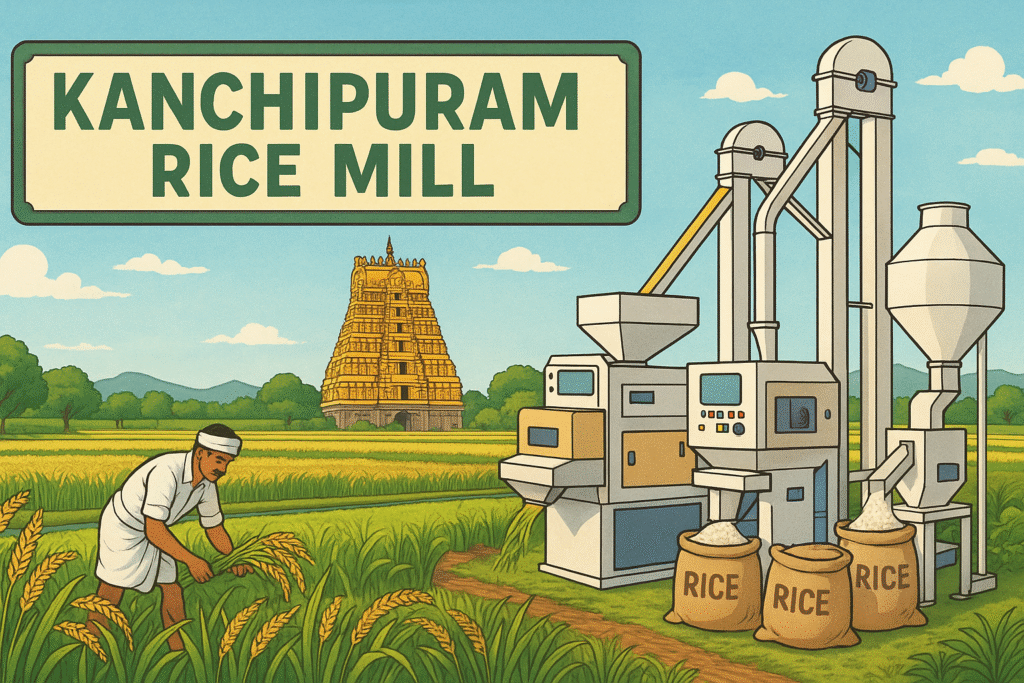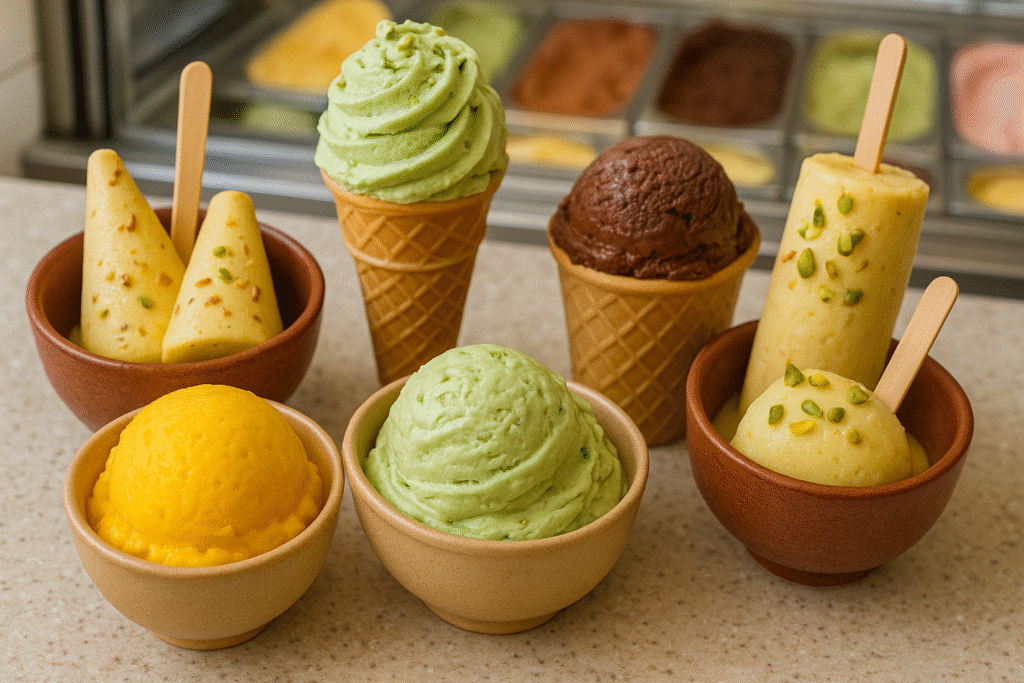The Edible Oil Manufacturing Story
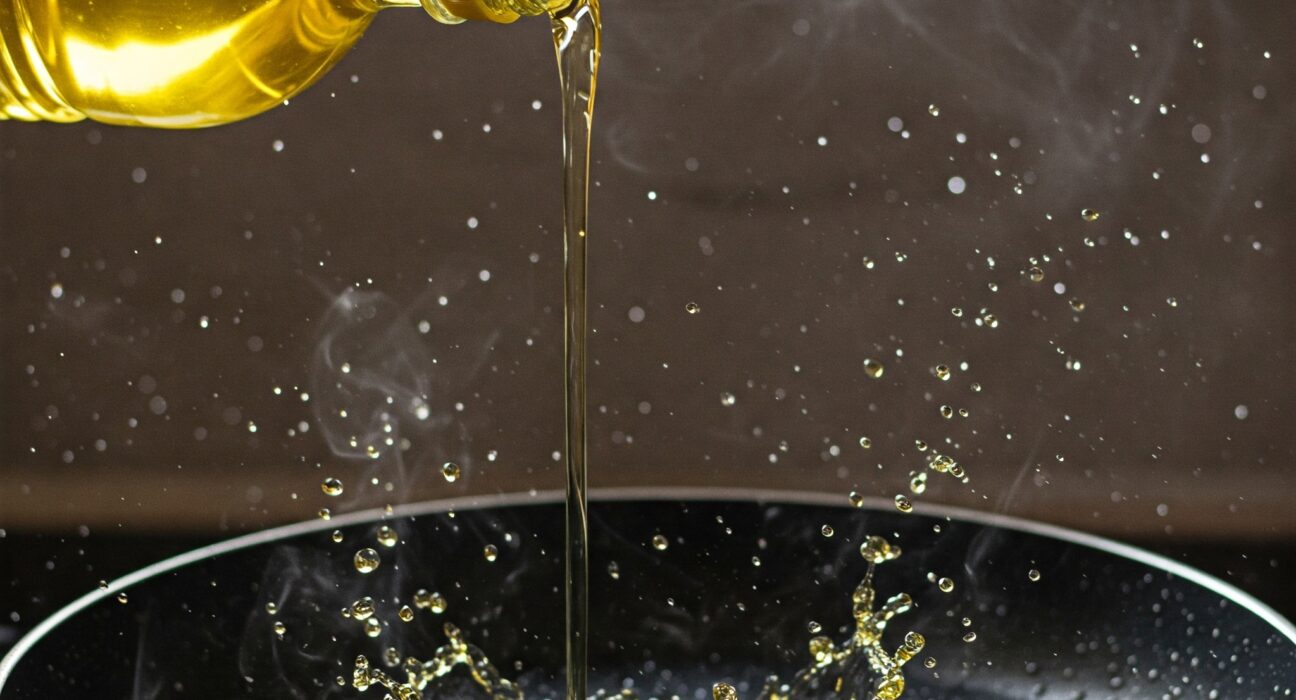
In this blog post, we writing about one of the important ingredient for most of foods, yes its Edible oil
Edible oils are fundamental components of the human diet and play a critical role in the global food industry. The journey from raw agricultural produce to the refined oil found on supermarket shelves is a complex and multifaceted process, involving a series of carefully controlled steps. This report aims to provide a comprehensive, expert-level explanation of the edible oil manufacturing process, encompassing the various stages from the initial selection of raw materials to the final packaging of the product.
1. Raw Materials for Edible Oil Production
The production of edible oils commences with the selection of appropriate raw materials, which are broadly classified into oilseeds, fruits, and other sources. India, with its diverse agro-climatic zones, cultivates a wide array of oilseed crops, each with varying oil content. Among the major oilseeds consumed and processed in India are soybean, mustard/rapeseed, groundnut, sunflower, sesame, safflower, linseed, niger seed, castor, cottonseed, corn, and rice bran. Additionally, palm kernel is also a source of edible oil. Beyond these, less common oilseeds like almond, walnut, grapeseed, canola, mahua, taramira, phulwara, mango kernel, dhupa, kokum, salseed, watermelon seed, cocoa butter, camelina, and tea seed also contribute to the edible oil landscape. The oil content within these seeds can vary significantly, ranging from approximately 5% in fenugreek seeds to over 55% in apricot kernels.
Regional preferences for specific edible oils are prominent in India, shaped by the availability of locally grown oilseeds and traditional culinary practices. For instance, a study in Nagpur indicated that groundnut and soybean were the most preferred edible oils. Across broader regions, mustard oil is favored in the north and east of India, while soybean and sunflower oils are more commonly consumed in the west. In the southern parts of the country, sunflower oil and groundnut oil are popular choices. Traditional cooking practices also dictate oil preferences, with sesame oil being a staple in Tamil Nadu, peanut oil traditionally used for deep frying, coconut oil favored in Kerala, and mustard oil preferred in Bengal.
Fruits also constitute a significant source of edible oils. Palm oil, derived from the pulp of the palm fruit, is a dominant edible oil globally and in India, which is a major importer and consumer. Coconut oil, extracted from the white meat of the coconut, is particularly popular in South India due to its regional abundance and affordability. Olive oil, obtained from the flesh of fresh olives, is gaining traction in India, with increasing demand for its perceived health benefits and culinary applications. Other fruit-based oils, such as avocado oil, also contribute to the diversity of edible oils available.
Beyond oilseeds and fruits, corn oil is derived from the germ of the corn kernel. In India, while soybean oil production has significantly increased over the years, the production of oils like niger, safflower, and sunflower has seen a relative decrease. Non-conventional sources such as rice bran oil and cottonseed oil also hold importance in the Indian edible oil market.
The wide variety of oilseed crops cultivated across India, influenced by its diverse agro-climatic conditions, directly contributes to the regional preferences observed in edible oil consumption. This regional specificity in demand necessitates a flexible and diverse manufacturing sector capable of processing a range of raw materials to meet local requirements. Furthermore, while seed oils form a substantial part of the edible oil market, fruit-based oils like palm, coconut, and olive oil hold considerable importance both globally and within India. The distinct physical structures of seeds versus fruits necessitate different approaches in their processing, impacting both the extraction and subsequent refining stages. India’s significant reliance on imports, particularly for palm oil, highlights the importance of both efficient domestic production and a robust global supply chain to meet the nation’s edible oil demands.
2. Pre-Extraction Processing of Oilseeds and Fruits
Before the oil can be extracted, the raw materials undergo a series of pre-processing steps to prepare them for efficient oil recovery and to ensure the quality of the final product. For oilseeds, the initial stage involves cleaning to remove extraneous materials such as soil, stones, and metal fragments. Magnets are often employed to capture any metallic contaminants, preventing damage to processing equipment and ensuring product safety. Following cleaning, many oilseeds undergo dehulling or deskinning, the removal of the outer layers of the seed. This process improves the efficiency of oil extraction and reduces the amount of impurities like fiber in the extracted oil and the resulting meal, enhancing its value as animal feed.
The next step for oilseeds is size reduction, typically achieved by grinding or crushing the seeds or nuts into a coarse meal using mechanized grooved rollers or hammer mills. Increasing the surface area of the material facilitates more effective oil extraction, whether through mechanical pressing or solvent extraction. Uniform particle size is crucial for ensuring consistent pressure distribution during pressing and better penetration of the solvent if that method is employed. Often, the ground meal undergoes conditioning, a heating process to a specific temperature. This heating reduces the viscosity of the oil, ruptures the oil-bearing cells within the seed, and facilitates its release, thereby maximizing oil yield. However, precise temperature control is essential to avoid degrading the quality of the oil.
The preparation of fruits for oil extraction differs based on the type of fruit. For palm oil, the oil-bearing fruit needs to be processed as quickly as possible after harvesting to prevent deterioration. This typically involves sterilization of the fresh fruit bunches, followed by stripping of the individual fruits and digestion to break down the fruit structure and release the oil. Olive oil production involves crushing the flesh of fresh olives, often using mechanical methods like a millstone or hammer mill, to liberate the oil. For coconut oil, the process begins with extracting the white meat from the coconut, which is then typically grated before undergoing either wet or dry processing to extract the oil.
The pre-processing steps are clearly adapted to the specific nature of the raw material. Oilseeds, with their protective outer layers and oil contained within the kernel, necessitate a more involved preparation process compared to some fruits where the oil is more readily accessible. This fundamental difference underscores the need for specialized equipment and tailored protocols for each type of oil source to achieve optimal efficiency and maintain the quality of the extracted oil.
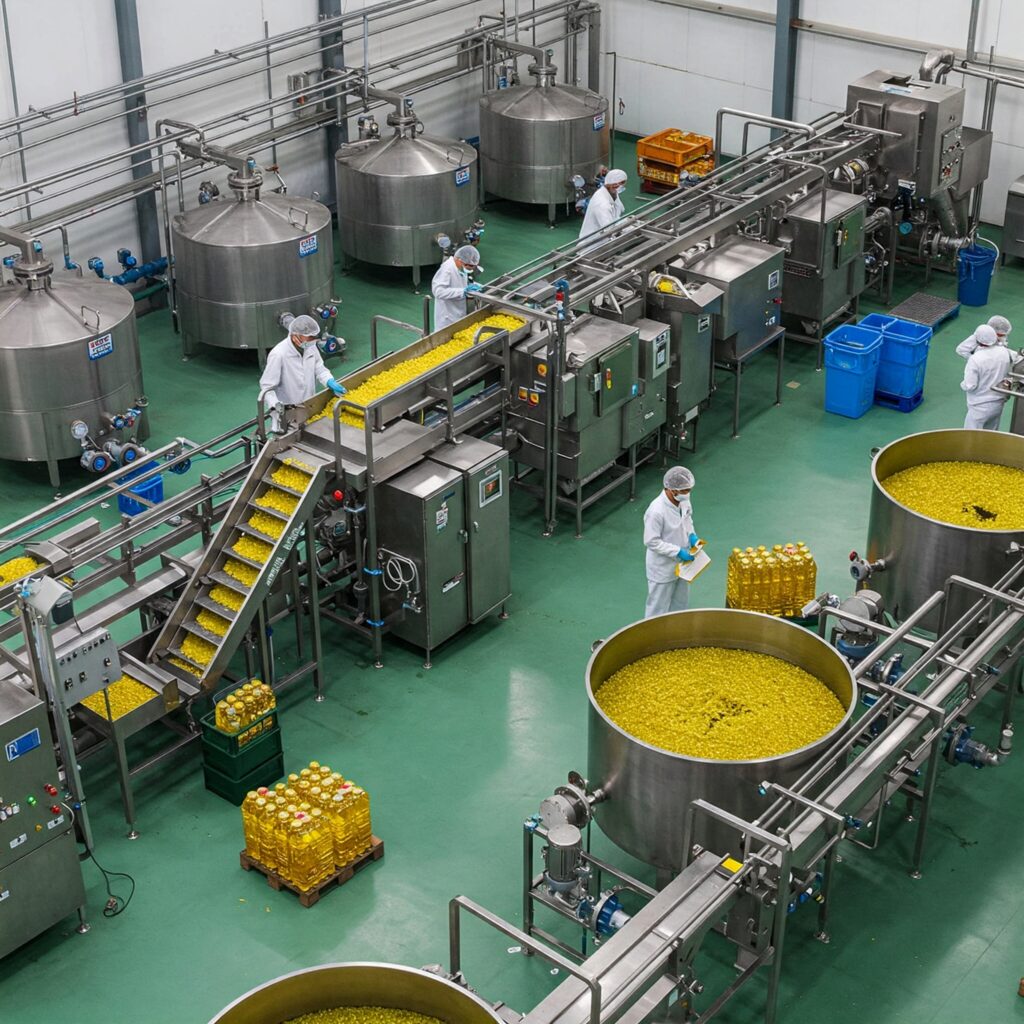
3. Methods of Oil Extraction
Once the raw materials have been appropriately prepared, the next critical stage in edible oil manufacturing is the extraction of the oil. Two primary methods are employed for this purpose: mechanical pressing (expelling) and solvent extraction.
Mechanical pressing, also known as expelling, involves subjecting the prepared and often heated meal to high pressure to physically squeeze out the oil. In a typical screw press, the heated meal is continuously fed into a barrel containing a screw mechanism. As the screw rotates, the pressure on the meal progressively increases as it moves through the barrel, which is slotted to allow the oil to escape. The pressure generated can range from approximately 68,950 to 20,6850 kilopascals. The oil that is squeezed out flows through the slots and is collected for further processing. While early vegetable oil extraction techniques using pressing might have only recovered around 10% of the available oil, modern expeller presses are significantly more efficient. For certain types of oils, such as olive, peanut, and some coconut and sunflower oils, a method called cold pressing is utilized. This technique involves minimal processing and lower temperatures, helping to preserve the natural flavor and aroma of the oil. In some cases, mechanical pressing is followed by chemical extraction to maximize the overall oil yield, ensuring that less than 1% of the oil remains in the meal.
Solvent extraction is often employed to recover the oil remaining in the pressed cake after mechanical pressing, or as the primary extraction method for oilseeds with relatively low oil content, such as soybeans and rice bran. In this process, a food-grade solvent, most commonly hexane, is added to the oil-bearing material. The solvent dissolves the oil, forming a mixture called miscella. The oil-rich miscella is then separated from the solid material, and the solvent is subsequently removed through a distillation process, which takes advantage of the different boiling points of the oil and the solvent. To minimize solvent loss and environmental impact, the evaporated solvent is typically condensed and collected for reuse. A small amount of residual solvent in the extracted oil is further removed using a stripping column where steam is passed through the oil.
Mechanical pressing offers the advantage of being a simpler process that avoids the use of chemical solvents, which can be appealing for certain applications and to consumers who prefer minimally processed foods. However, it is generally less efficient in terms of oil yield compared to solvent extraction. Solvent extraction, on the other hand, ensures that the maximum possible amount of oil is recovered from the raw material, which is particularly important for oilseeds with lower oil content like soybeans, making their large-scale production economically viable. The choice between these two methods, or the use of both in combination, is often dictated by factors such as the oil content of the raw material, the desired quality attributes of the final product (including flavor profile and the presence of specific compounds), and the overall cost-effectiveness of the manufacturing process. The increasing consumer interest in health and wellness is also driving a demand for cold-pressed oils, which are perceived as being more natural and retaining more nutrients.
4. The Edible Oil Refining Process: Ensuring Quality and Purity
The crude oil obtained from extraction processes contains not only triglycerides but also a variety of other components, including free fatty acids, phospholipids (gums), waxes, pigments, oxidation products, trace metals, and other impurities. These impurities can negatively impact the oil’s flavor, odor, color, appearance, stability, and suitability for various culinary and industrial applications. To produce a high-quality, consumable product, the crude oil undergoes a series of refining steps, typically involving degumming, neutralization, bleaching, and deodorization (collectively known as RBD). Some oils may require additional processing like winterization/dewaxing and fractionation. Refining can be achieved through alkaline refining or physical refining. The scale of operations can range from batch to semi-continuous to fully continuous processes, depending on the production volume.
Degumming is the first step in refining and aims to remove phospholipids, also known as gums. These phospholipids can cause increased viscosity, darkening of the oil, and can lead to issues during subsequent refining stages, such as filtration. Several methods are used for degumming, including water degumming (using hot water or steam to hydrate and precipitate the phospholipids), acid degumming (using phosphoric or citric acid to condition and remove non-hydratable phospholipids), dry degumming (for oils with low phospholipid content), soft degumming (using chelating agents), total degumming, membrane degumming (employing ultrafiltration), and enzymatic degumming (using enzymes to hydrolyze phospholipids). A common small-scale technique involves an acid wash of the raw pressed oil using citric acid, which helps in settling out the hydratable compounds. In water degumming, injecting hot water or steam into the warm oil causes the phospholipids to absorb water, become insoluble in oil, and agglomerate into a gum phase, which is then separated using centrifugation.
Neutralization is the process of removing free fatty acids (FFAs) from the oil. High levels of FFAs can lead to rancidity and impart undesirable flavors to the oil. Alkali refining (chemical neutralization) is a common method where an alkali solution, such as sodium hydroxide, is added to the oil. This reacts with the FFAs to form soapstock, which also absorbs other suspended impurities and is then separated from the oil. Physical refining, on the other hand, involves steam stripping at high temperatures (typically 240-260°C) under vacuum to remove FFAs by volatilization, and is particularly suitable for oils like palm oil that have a high FFA content.
Bleaching is carried out to remove color pigments and other impurities that can affect the appearance and quality of the oil. This step involves mixing the oil with bleaching agents, such as bleaching earth (bentonite or activated clay) and/or activated carbon. These adsorbents bind to impurities like chlorophyll, carotenoids, oxidation products, trace metals, and residual soaps and gums. The mixture is typically heated under vacuum to enhance the adsorption process , with temperatures ranging from 90°C to 110°C. The bleaching agents, now laden with impurities, are then removed from the oil by filtration using equipment like filter presses or vertical pressure leaf filters. Factors such as moisture levels, temperature, contact time, and the degree of vacuum significantly influence the efficiency of the bleaching process.
Deodorization is a crucial step to remove any remaining unpalatable flavors and odors from the oil. This is achieved by steam distillation under high temperature (225-250°C or 440-485°F) and high vacuum (2-8 mmHg). Steam is passed through the hot oil in a vacuum, causing volatile compounds responsible for taste and odor, such as aldehydes, ketones, alcohols, and short-chain fatty acids, to distill off. Deodorization also helps in removing any remaining free fatty acids and other volatile contaminants. After deodorization, the oil is often conditioned under nitrogen to protect it from oxidation.
Some edible oils require additional refining steps to meet specific quality requirements or application needs. Winterization or dewaxing is a process used to remove waxes and high melting point triglycerides that can cause cloudiness or turbidity in oils like sunflower, corn, and cottonseed oil when subjected to low temperatures. This thermo-mechanical process involves cooling the oil under controlled conditions to induce the crystallization of these waxy substances. The formed crystals are then mechanically separated from the oil through filtration or centrifugation. For sunflower oil, this step is commonly referred to as dewaxing.
Fractionation is another specialized refining process, primarily used for oils like palm oil to separate them into components with different melting points. Palm oil is typically separated into a liquid fraction (olein) and a solid fraction (stearin) through a process of controlled heating and cooling, which promotes crystallization of the higher melting point triglycerides (stearin). The solid crystals are then separated from the liquid olein by filtration. Common fractionation methods include dry fractionation (cooling and filtration without solvents), detergent fractionation, and solvent fractionation. Dry fractionation is often preferred due to its cost-effectiveness and good yield.
The refining process, therefore, is a carefully orchestrated sequence of steps, each designed to remove specific impurities or separate particular components from the crude oil. The specific steps and the conditions under which they are carried out are tailored to the type of oil being processed and the desired quality attributes of the final product. While refining is essential for improving the quality and stability of edible oils, it is important to note that some steps, such as deodorization, can potentially remove beneficial bioactive compounds present in the crude oil. This presents a balance that manufacturers must consider to ensure both the purity and the nutritional value of their products.
5. Manufacturing Variations for Different Types of Edible Oils

The edible oil manufacturing process is not uniform across all types of oils; rather, it exhibits significant variations depending on the source (seed or fruit) and the specific characteristics of the oil. Seed oils generally require more extensive pre-processing compared to fruit oils. For instance, seeds typically need dehulling and grinding to release the oil-rich kernel, whereas some fruit oils, like olive oil, can be obtained through simpler pressing methods. While the core refining steps (degumming, neutralization, bleaching, deodorization) might be similar for both seed and fruit oils, the specific conditions such as temperature, time, and the types of reagents used can vary based on the initial composition of the oil and the nature of the impurities present. A notable example is palm oil, a fruit oil that commonly undergoes fractionation to separate it into olein and stearin fractions, a process not typically applied to most seed oils. Conversely, sunflower oil, a seed oil, often requires dewaxing (winterization) to remove waxes, a step that is less common in the processing of fruit oils like olive oil.
High oleic sunflower oil, a specialized type of seed oil with a high concentration of oleic acid, typically undergoes the RBDW process, which includes a crucial winterization step to ensure clarity, especially when stored at lower temperatures. This is important because these oils are often used in applications like salad dressings where visual appeal is key. Cold-pressed oils, on the other hand, whether derived from seeds or fruits, involve minimal processing, often limited to cleaning and pressing at relatively low temperatures. This approach aims to retain the natural flavor, aroma, and potentially a higher content of nutrients, but these oils might have a shorter shelf life due to the presence of unrefined components. Refined oils, in contrast, undergo the full spectrum of refining processes to remove impurities, color, odor, and flavor, resulting in a neutral oil that is more stable and suitable for high-heat cooking applications.
The manufacturing process is therefore highly adaptable, tailored to the unique characteristics of the oil source and the desired properties of the final product. This necessitates a thorough understanding of the chemical and physical properties of each oil type to optimize the process. For instance, the high unsaturated fat content in certain nut oils makes them more susceptible to oxidation, often requiring specialized storage conditions like refrigeration. The high saturated fat content in palm oil makes fractionation a necessary step for many of its applications. The choice between cold-pressing and refining depends on the intended use and the desired balance between natural flavor and stability.
6. Quality Control Standards for Edible Oils in India (FSSAI Regulations)

In India, the quality and safety of edible oils are rigorously regulated by the Food Safety and Standards Authority of India (FSSAI). Established under the Ministry of Health and Family Welfare, Government of India, the FSSAI sets science-based standards for food articles and regulates their manufacture, storage, distribution, sale, and import to ensure food safety. Any food business operator involved in these activities, including those in the edible oil industry, is required to obtain a license or registration from the FSSAI, with the type of license depending on the business’s turnover.
The FSSAI has laid down comprehensive regulations and standards for edible oils, primarily through the Food Safety and Standards (Food Products Standards and Food Additives) Regulations, 2011. These regulations define “Refined vegetable oil” and the “Refining” process itself. They also specify quality parameters for a wide range of edible oils, including physical and chemical characteristics such as Butyro-refractometer reading, Refractive Index, Saponification value, Iodine value, Unsaponifiable matter, and Acid value. For example, mustard oil is required to have a Butyro-refractometer reading at 40°C between 55.6 and 60.2 or a Refractive Index at 40°C between 1.4630 and 1.4660. The regulations also mandate specific quality assurance tests to assess parameters like acidity, peroxide value, fatty acid composition, and the presence of contaminants such as heavy metals, pesticides, and residues of solvents used in extraction processes. For solvent-extracted refined oils, the limit for hexane residue is set at a maximum of 5.0 ppm. Specific standards are also outlined for oils like virgin olive oil, refined olive oil, and olive pomace oil, covering various quality indicators.
To ensure compliance, the FSSAI has notified numerous laboratories, including NABL accredited private labs and state/UT labs, for food testing. The FSSAI also provides manuals detailing the methods for determining various quality parameters, such as Unsaponifiable Matter, Acid Value, Iodine Value, and Fatty Acid Composition using Gas-Liquid Chromatography (GLC). Furthermore, specific tests are prescribed for detecting adulterants like argemone oil, mineral oil, and animal body fat.
Beyond product standards, the FSSAI also emphasizes hygiene and sanitary practices that Food Business Operators must adhere to, as outlined in Schedule 4 of the Food Safety and Standards (Licensing & Registration of Food Businesses) Regulations, 2011. These requirements cover aspects such as the design and maintenance of food processing facilities, the cleanliness of equipment, proper waste disposal, the quality of water used, personal hygiene of food handlers, and effective pest control measures to prevent contamination. The principles of Hazard Analysis and Critical Control Points (HACCP) are also integral to ensuring food safety in edible oil manufacturing.
The FSSAI’s comprehensive regulatory framework plays a vital role in ensuring the safety and quality of edible oils available to consumers in India. By setting clear standards, mandating testing, and enforcing hygienic practices, the FSSAI aims to protect public health and maintain the integrity of the edible oil supply chain. The continuous development and revision of these standards reflect an ongoing commitment to ensuring the safety and quality of food products in India.
7. Packaging and Storage of Edible Oils to Maintain Quality
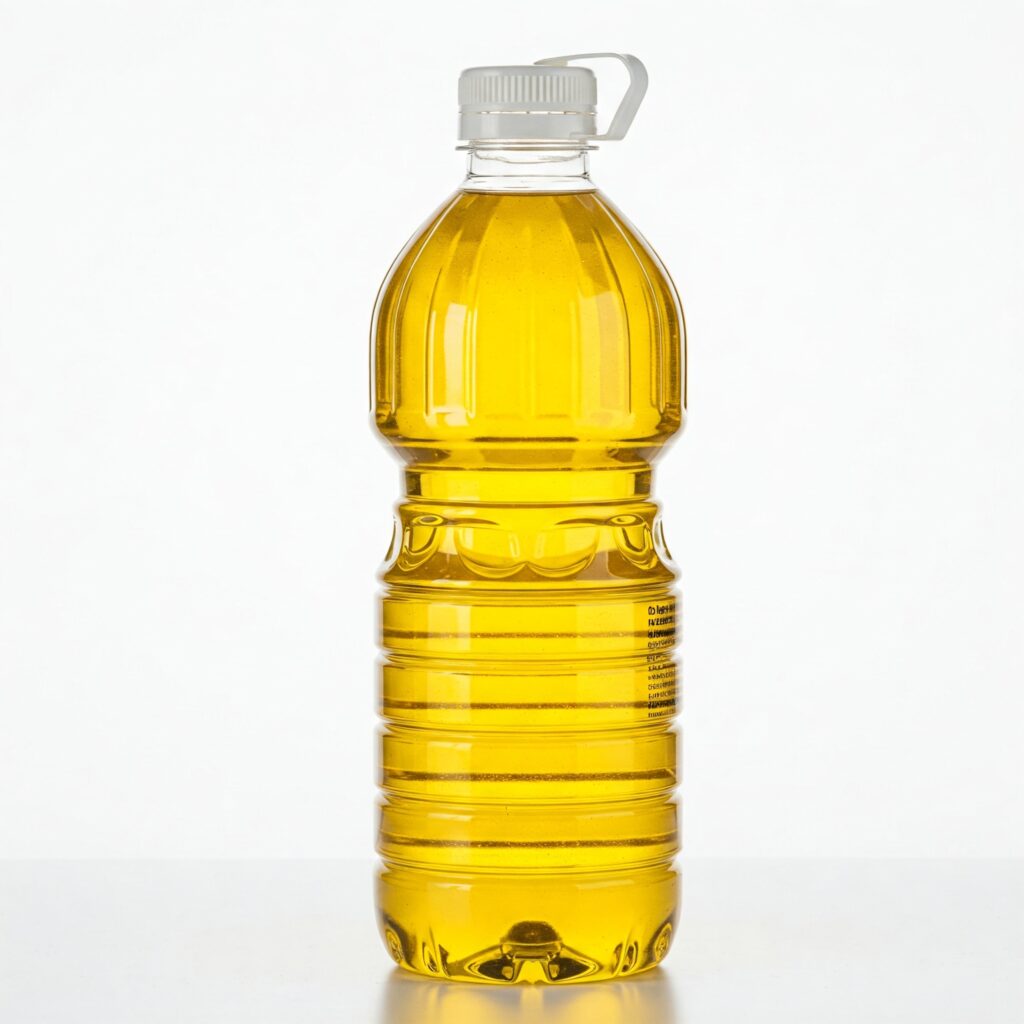
The final stages of edible oil manufacturing, packaging and storage, are critical for maintaining the quality, flavor, aroma, and nutritional value of the product and extending its shelf life. A variety of packaging materials are used for edible oils, including glass and plastic bottles (made from materials like HDPE, PET, and PVC), metal tin containers, flexible pouches made of plastic and foil laminates, and bag-in-box systems for bulk quantities. Glass bottles offer excellent protection against light, oxygen, and moisture, which is beneficial for preserving the oil’s quality, but they are fragile and heavier, potentially increasing transportation costs. Dark-colored glass, such as amber or green, is often preferred as it helps to block harmful UV rays that can accelerate the oxidation process. Plastic bottles, especially those made from PET, are lightweight, shatter-resistant, and provide a good barrier against odors and oxygen, making them a popular choice. Metal tin containers offer robust protection against light, oxygen, and moisture, making them suitable for larger quantities and ensuring a longer shelf life. However, they often require inner linings to prevent corrosion. Flexible pouches are a cost-effective and space-efficient option for packaging edible oils, although their barrier properties can vary depending on the materials used in their construction. Regardless of the packaging material, airtight seals are essential to prevent the entry of air, moisture, and contaminants, which can lead to oxidation, rancidity, and microbial growth.
Proper storage conditions are equally important for preserving the quality of edible oils. Oils should be stored in a cool, dark, and dry place, away from sources of heat such as stoves, ovens, and direct sunlight. The ideal storage temperature is generally around room temperature (approximately 70°F or 21°C), and it is important to avoid significant temperature fluctuations. Extra virgin olive oil, for example, is best stored between 55 to 60°F. Exposure to heat, light (particularly UV rays), and oxygen accelerates the process of lipid oxidation, which leads to the development of undesirable flavors and odors (rancidity) and reduces the oil’s nutritional value and shelf life. It is crucial to keep the containers tightly closed after each use to minimize exposure to air and prevent oxidation. Using dark or opaque containers helps to limit light exposure. If clear bottles are used, they should be stored in a cupboard or wrapped in foil to block out light. Edible oils should also be stored away from strong-smelling foods or cleaning supplies, as they can absorb odors, affecting their flavor and aroma. It is recommended to use the oil within a reasonable timeframe, typically within the use-by date or within six months to a year after opening, depending on the type of oil and the storage conditions. More delicate oils with a higher content of unsaturated fats, such as flaxseed or walnut oil, have a shorter shelf life and may benefit from refrigeration. Labeling containers with the date of opening can help track freshness and ensure that older oil is used before newer oil.
Proper packaging that provides an effective barrier against oxygen, light, and moisture, combined with storage in appropriate cool, dark, and dry conditions, is essential for maintaining the quality, flavor, aroma, and nutritional value of edible oils and for extending their shelf life. Selecting the right packaging material and adhering to recommended storage practices are vital for minimizing oxidation, preventing rancidity, and ensuring that consumers receive a safe and high-quality product.
The manufacturing of edible oils is a complex process that transforms diverse agricultural raw materials into essential food products. This journey encompasses several key stages, starting with the careful selection and preparation of raw materials such as oilseeds and fruits. The oil is then extracted through mechanical pressing, solvent extraction, or a combination of both, depending on the oil content and desired quality. The crude oil undergoes a series of refining steps, including degumming, neutralization, bleaching, and deodorization, to remove impurities and ensure its suitability for consumption. Some oils may require additional processing like winterization/dewaxing or fractionation to meet specific quality or application requirements. Throughout the manufacturing process, stringent quality control measures, particularly those mandated by regulatory bodies like the FSSAI in India, are crucial to guarantee the safety and quality of the final product. Finally, appropriate packaging and storage are essential to maintain the oil’s quality, flavor, aroma, and nutritional value over its shelf life. The edible oil manufacturing process is therefore a testament to the integration of agricultural practices, chemical engineering principles, and quality assurance measures, all working in concert to provide a vital component of the global food supply.



